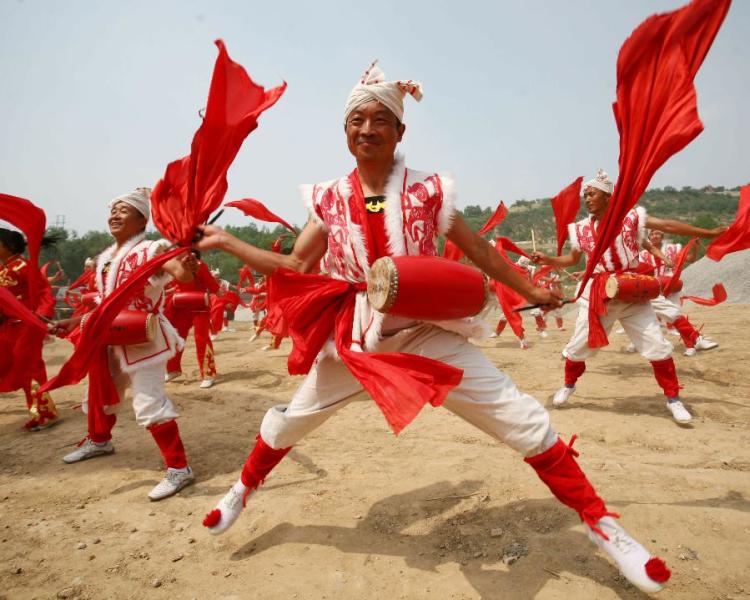Waist drum performance
231 views · Organized by 碍与暧 on 2022-02-10
The performance of the waist drum is closely integrated with the dance movements, which is called "waist drum". Originally popular in Ansai, Hengshan, Mizhi, Zizhou and other places in northern Shaanxi, Ansai and Hengshan are the most popular.
The performance form of waist drum can be roughly divided into "road drum" and "field drum".
The performance form of waist drum can be roughly divided into "road drum" and "field drum".

road drum
A form of performance in which the waist drum team walks and dances during the march. The front is led by two umbrella heads, followed by the dance team B, which consists of a drum and a lahua. "Toulu Guzi", the first luguzi must be a skilled drummer. The whole team's movement changes and rhythm are fast and slow, and he will be the commander. At the back of the team, there are buffoons dressed as barbarians and barbarians, and some dressed as characters from Monkey King, Zhu Bajie, and other Tang monks from the Buddhist scriptures. Because "Road Drum" is performed during the march, the general movements are simple and the amplitude is small, and more actions such as "cross steps", "walking steps", "horse steps around the waist" are performed. The commonly used formations are "single crossing", "double crossing" "Crossing the Street", "Single Dragon Swinging Tail", "Double Dragon Swinging Tail" and so on.venue drum
Refers to the performance form after the waist drum team arrives at the performance location and opens the venue. At the beginning, the umbrella head waved the umbrella, and all the dancers danced with the umbrella head. This section is called "stepping on the big field", and the performance is slow-paced. The purpose is to open the venue, open the team, and stabilize the audience's emotions. In the second section of singing and dancing, the rhythm of the performance became faster, the range of movements was larger, and the formation changed a lot. Commonly used formations include "God's Tower", "Ancient Temple", "Gold Medal in Front of God", "Rich and Noble Ending", "Monk Touring the Gate" and so on. After the "Sun Arc" pattern is drawn, Umbrella Head stands in the center of the venue to sing Yangko, and the lyrics depend on the occasion and object. When "visiting the temple", there are temple worship texts, and general performances include greetings to the audience for the New Year, as well as festive harvests and wishes. Auspiciousness, etc. When the umbrella head sings, the dancers walk in circles on the sidelines and repeatedly sing the last sentence of each paragraph, commonly known as "sound after". After singing, the umbrella head exited the venue, and the drum and lahua entered the venue to perform, and walked out of various complicated and changeable formations. At this moment, there is no time limit, the dancers express their unique skills to the fullest, with warm emotions and ups and downs, making the performance reach a climax. In recent years, in order to highlight the skill of carrying the drum, the waist drum is performed by the drum in the field alone when performing the "field drum". Under the command of Tolu Guzi, the drummers were in high spirits and danced wildly. At this time, they saw the drumsticks waving, the colorful silk flying, and the drums were thundering, shaking the earth, the momentum was compelling, and it was very infectious. After this section is over, other forms of small performances will be interspersed, such as "Running Donkey", "Water Boat", "Stilts", "Two Ghosts Fight", "Big Head Monk" and so on. The number of program forms depends on the talents and conditions of each village. After the small show was over, a large-scale waist drum was performed. At this moment, the gongs and drums are beat fast, the suona is blown tight, the drumming is more intense, and the mood is more cheerful, making the whole performance end in a strong atmosphere and high mood.Involving musical instruments
The waist drum (pinyin: Yāogǔ) is one of the traditional Han nationality musical instruments, and it is an ancient national musical instrument of the Chinese Han nationality. It originates from life and expresses life well. The waist drum is a national musical instrument with a long history and crisp sound. the artistry.
Guess you like
Organized by 苏肆 on 2022-02-10
Waist drums are divided into literary and martial arts according to different styles and rhythms. "Wenyaogu" is light-hearted, unrestrained and lively, with a small range of movements, similar to the style of Yangko; , jumping and spinning movements, especially the drummer's flying and leaping skills, give people a feeling of heroism and agitation.
read >>
 渝公网安备 50010702504639号
渝公网安备 50010702504639号